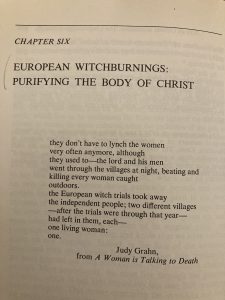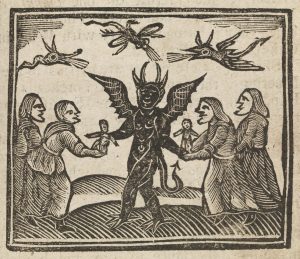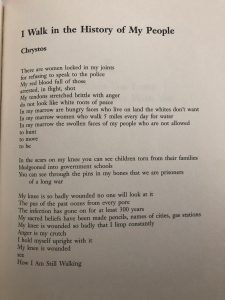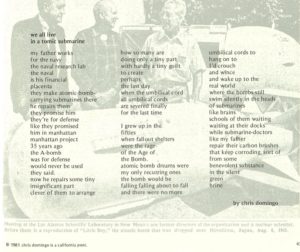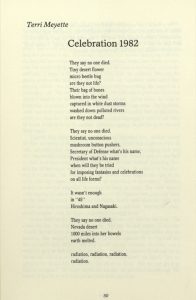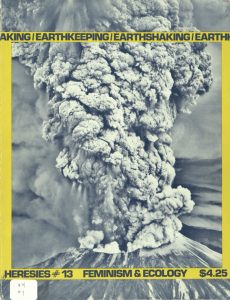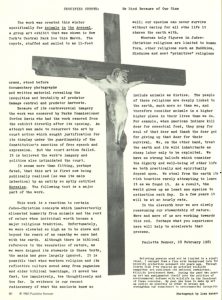
The first Earth Day held on April 22, 1970.
Although the connections between the conditions of women and nature were first identified in the United States as early as the late 1800’s, the term ecofeminism was first proposed in 1974 by the French feminist Francoise d’Eaubonne in Feminism or Destruction (Le Feminisme ou la mort). She called on women to lead an ecological revolution and to recreate a relationship of reciprocity between humanity and nature as well as men and women. Nevertheless, ecofeminism as a movement branched out across the world, reaching the United States in the midst of the emerging Second Wave Feminist Movement and the Ecological Movement of the 1970’s. The beginning of the modern environmental movement can be traced back to the publication of Rachel Carson’s Silent Spring in 1962, which raised concerns that capitalism and its intrinsic need for the exploitation of the earth’s resources threatened human health and endangered natural ecosystems and their inhabitants. To raise awareness about environmental issues such as oil spills, pollution, soil contamination, and toxic waste, the first Earth Day was held on April 22, 1970, symbolizing a turning point in the growing ecological consciousness that recognized the interdependence of living beings. Inspired by the culture of political activism developed by the Civil Rights Movement and the Anti-War Movement in the 1960s, the 1970s became a critical decade for the introduction of federal legislation concerning the environment, including the creation of the Environmental Protection Agency in 1970, the passage of the Clean Air Act in 1970, the Clean Water Act in 1972, and the Endangered Species Act in 1973, among others.

The first edition of Woman and Nature: The Roaring Inside Her, published in 1978.
One of the most influential texts written during this period and credited for inspiring the birth of the ecofeminist movement in America was Woman and Nature: The Roaring Inside Her by Susan Griffin, a book-length prose poem published in 1978. In the preface of this book, Griffin states that “the fact that man does not consider himself as part of nature, but indeed considers himself superior to matter, seemed to [her] to gain significance when placed against man’s attitude that woman is both inferior to him and closer to nature,” (xv) and hence, this book was written. The book is separated into four sections: Book One: Matter (How man regards and makes use of woman and nature); Book Two: Separation (The separations in his vision and under his rule); Book Three: Passage (Her Journey through the Labyrinth to the Cave where she has Her Vision); and Book Four: Her Vision (Now she sees through her own eyes).
In Book One: Matter, Griffin identifies how the root of patriarchal oppression is the relegation of women to the realm of matter–of the body, of nature– and the dichotomy itself that fragmented reality into the spirit/matter duality, with the former oppressing the latter. Because of women’s cyclical biological functions and life-giving properties, such as pregnancy and menstruation, they were associated with nature. Hell, observes Griffin, is “under our feet” and the demon “resides in the earth” (7). Hence, it is said that women are the gateway to the devil, leading to the corruption of man, because “all sin originated in the flesh of the body of a woman and lives in her body” (11). Griffin highlights the patriarchal belief that all of nature, including women, was designed by God for the benefit of man. Fossil fuels were placed under his feet for him to extract, animals were created to be hunted, the wilderness was meant to be civilized, and women existed solely for the propagation of the human race.
In Book Two: Separation, Griffin illustrates how the patriarchy separates women from their own bodies, which have been deemed impure, unholy, and unclean. The womb is separated from her body, as the woman is merely a vessel that carries the seed of man, who is the true giver of life. Women are told that they exist solely for the needs of men, and that it is in their nature to be needed, to be reduced to their reproductive capabilities as resources for men. Traveling through the epochs of history, she outlines how the scientific revolution in the Age of Enlightenment led to the reduction of living organisms into mere resources to be measured, mutilated, and exploited by man. In the third and fourth books, the woman emancipates herself from the shackles of the patriarchal cave of illusions and steps into the light of feminist consciousness. Griffin reimagines the patriarchal world we live in by resurrecting a new age wherein women reclaim their interconnectedness with nature. Like the tree of life, all living beings branch out from the same tree. The consequences of destructive activities inflicted by mankind will reverberate across all levels of the ecosystem, which all species on earth are intrinsically part of. The core of ecofeminism recognizes that “we are all a part of this motion, we say, and the way of the river is sacred, and this grove of trees is sacred, and we ourselves, we tell you, are sacred” (186).
Sources:
“Environmental Movement.” Encyclopedia.com, 18 May 2018, https://www.encyclopedia.com/earth-and-environment/ecology-and-environmentalism/environmental-studies/environmental-movement. Accessed 5 December 2021.
Griffin, Susan. Woman and Nature : The Roaring Inside Her. 1st ed., Harper & Row, 1978.
Miles, Katherine. “Ecofeminism.” Britannica, 9 October 2018, https://www.britannica.com/topic/ecofeminism#ref313489. Accessed 3 December 2021.

